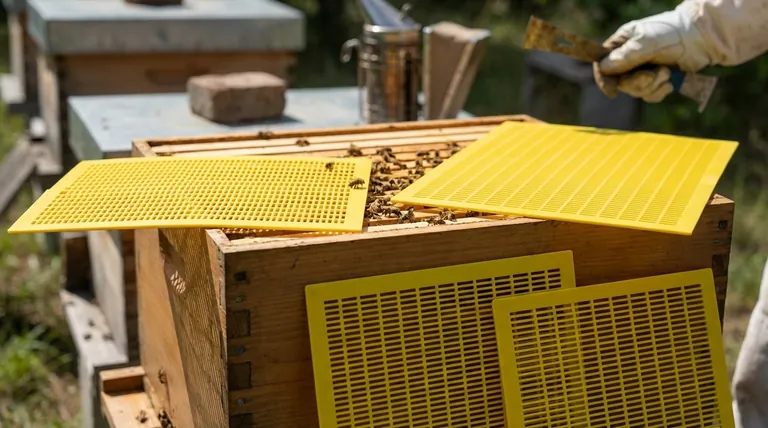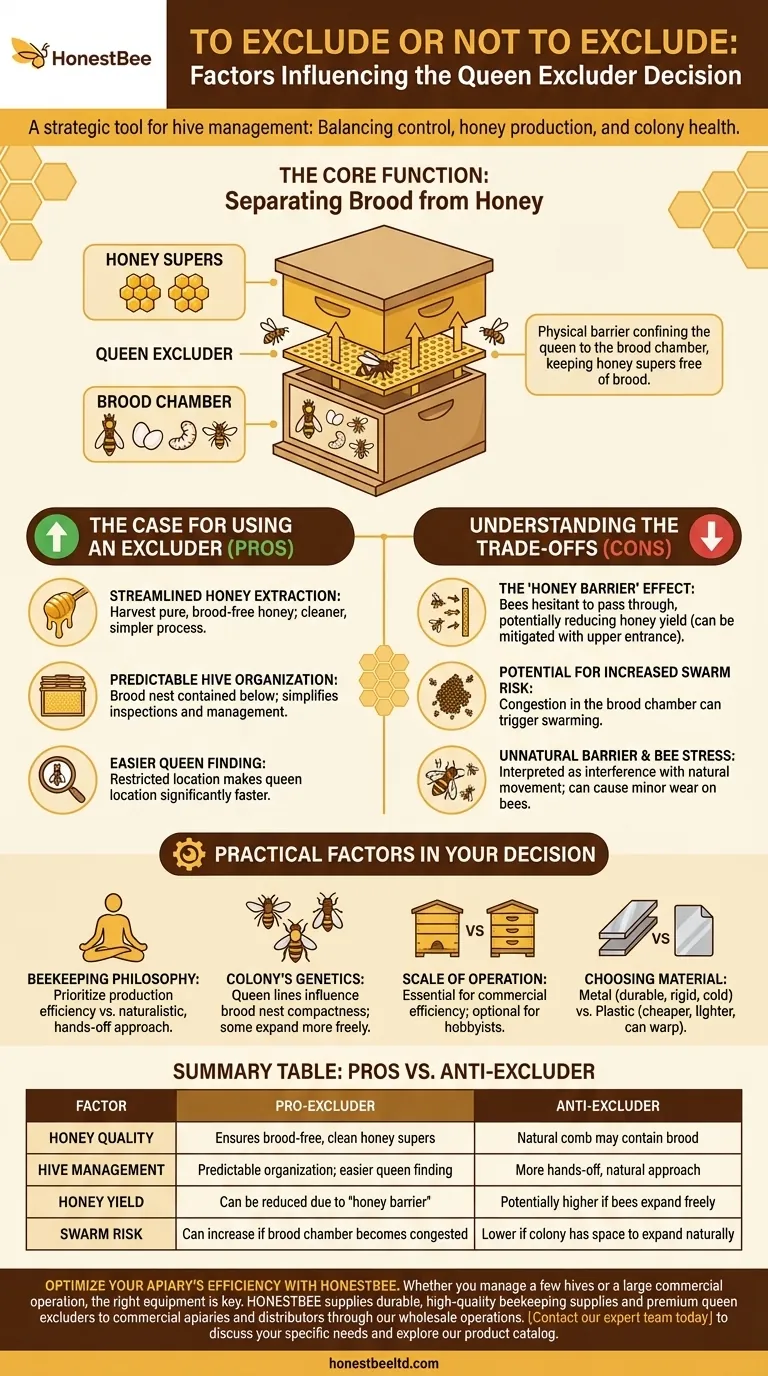The decision to use a queen excluder is driven by a combination of your specific beekeeping goals, your management philosophy, and the unique characteristics of your honey bee colony. It is not a universal requirement but a strategic tool used to enforce a specific hive structure, primarily to keep honey supers free of bee larvae, or brood.
A queen excluder is fundamentally a tool of control. The decision to use one hinges on a trade-off: you gain cleaner honey and a more organized hive at the potential cost of reduced honey production and a less natural hive environment.

The Core Function: Separating Brood from Honey
What is a Queen Excluder?
A queen excluder is a simple grid or perforated sheet placed between hive boxes. The openings are large enough for worker bees to pass through but too small for the larger queen bee and drones.
Its sole purpose is to create a physical barrier that confines the queen to a specific area of the hive, typically the lower boxes known as the brood chamber.
The Anatomy of the Hive
A standard hive is organized into two main sections. The brood chamber is where the queen lays her eggs and the colony raises its young. The honey supers are the boxes stacked above, intended exclusively for nectar processing and honey storage.
The queen excluder is placed directly between the top brood box and the bottom honey super.
The Primary Goal: Ensuring Brood-Free Honey
By keeping the queen out of the honey supers, you ensure these frames contain only honey. This makes the extraction process cleaner, simpler, and faster, as you don't have to work around patches of eggs, larvae, and pupae.
The Case For Using an Excluder
Streamlined Honey Extraction
The most significant benefit is harvesting pure, "clean" honey. Without an excluder, a queen may move upward and lay eggs in the frames you intend to harvest, creating a messy and difficult extraction.
Predictable Hive Organization
An excluder imposes order on the hive. You always know the brood nest is contained below it, which simplifies inspections. You can quickly assess the honey stores without disturbing the nursery of the hive.
Finding the Queen
When the queen's location is restricted to one or two boxes, finding her for inspection or replacement becomes significantly easier and faster, especially in a very large, populous colony.
Understanding the Trade-offs and Criticisms
The "Honey Barrier" Effect
The excluder can create a bottleneck. Worker bees may be hesitant to push through the barrier, leading to less traffic into the honey supers. This can result in the bees storing honey in the brood chamber instead, a condition known as being "honey bound."
This reluctance can sometimes reduce the overall honey yield of the hive. Providing a small upper entrance above the excluder can help mitigate this.
Potential for Increased Swarm Risk
If the bees are slow to move through the excluder, the brood chamber can become congested with bees and honey. This overcrowding is a primary trigger for the colony to swarm.
It's an Unnatural Barrier
Some beekeepers prefer a more natural approach, allowing the colony to organize itself. They argue the excluder interferes with the natural movement and expansion of the bee cluster, especially during seasonal changes.
Wear and Tear on Bees
Forcing thousands of bees through the narrow slots multiple times a day can cause minor damage, such as fraying their wings. While usually not catastrophic, it is a source of stress on the workforce.
Practical Factors in Your Decision
Your Beekeeping Philosophy
Your choice reflects your priorities. Do you value production efficiency and hive organization, or do you prefer a more hands-off, naturalistic approach that allows the bees greater autonomy?
Your Colony's Genetics
Different bee genetics influence behavior. Some queen lines, particularly those locally bred for northern climates, naturally keep a tight, compact brood nest. Others, like some wild-caught or Italian strains, are prolific layers and will expand the brood nest into any available space without an excluder.
Scale of Your Operation
For commercial beekeepers with hundreds of hives, excluders are an essential tool for efficiency. For a hobbyist with one or two hives, managing the brood nest without an excluder is much more feasible.
Choosing the Right Material
If you decide to use one, you must choose between metal and plastic. Metal excluders are more durable and rigid but also more expensive and can chill the hive in winter. Plastic excluders are cheaper and lighter but can warp or break over time.
Making the Right Choice for Your Apiary
Ultimately, you must make a decision based on observation and your personal goals.
- If your primary focus is maximizing pure honey yield and simplifying extraction: Using a properly installed queen excluder is the most effective strategy.
- If your primary focus is a "natural" beekeeping approach with less equipment: Avoid the excluder and manage the brood nest through careful and regular hive inspections.
- If you are a new beekeeper or are unsure: Start without an excluder, observe your queen's laying patterns, and add one only if she consistently moves into the honey supers.
Your best guide is always the hive itself; observe its behavior and manage it accordingly.
Summary Table:
| Factor | Pro-Excluder | Anti-Excluder |
|---|---|---|
| Honey Quality | Ensures brood-free, clean honey supers | Natural comb may contain brood |
| Hive Management | Predictable organization; easier queen finding | More hands-off, natural approach |
| Honey Yield | Can be reduced due to 'honey barrier' effect | Potentially higher if bees expand freely |
| Swarm Risk | Can increase if brood chamber becomes congested | Lower if colony has space to expand naturally |
Optimize Your Apiary's Efficiency with HONESTBEE
Whether you manage a few hives or a large commercial operation, the right equipment is key to balancing honey production with colony health. HONESTBEE supplies durable, high-quality beekeeping supplies and equipment—including premium queen excluders—to commercial apiaries and beekeeping equipment distributors through our wholesale-focused operations.
Let us help you make the best decision for your bees and your business. Contact our expert team today to discuss your specific needs and explore our product catalog.
Visual Guide

Related Products
- Professional Plastic Queen Excluder for Modern Beekeeping
- Wooden Queen Bee Excluder for Beekeeping
- Premium Wood Framed Metal Wire Queen Bee Excluder
- Metal Queen Bee Excluder for Beekeeping
- High Performance Plastic Queen Excluder for Beekeeping and Apiary Management
People Also Ask
- How do queen excluders work in terms of spacing and bee movement? A Guide to Precision Hive Management
- What is the primary function of a queen excluder in beekeeping? Control Hive Layout for Efficient Honey Harvesting
- What are the main advantages of using a queen excluder in beekeeping? Simplify Hive Management & Harvest
- What is the purpose of a queen excluder when adding a super? Streamline Your Honey Harvest
- How does a queen excluder work? Master Hive Management for Pure Honey Harvests



















